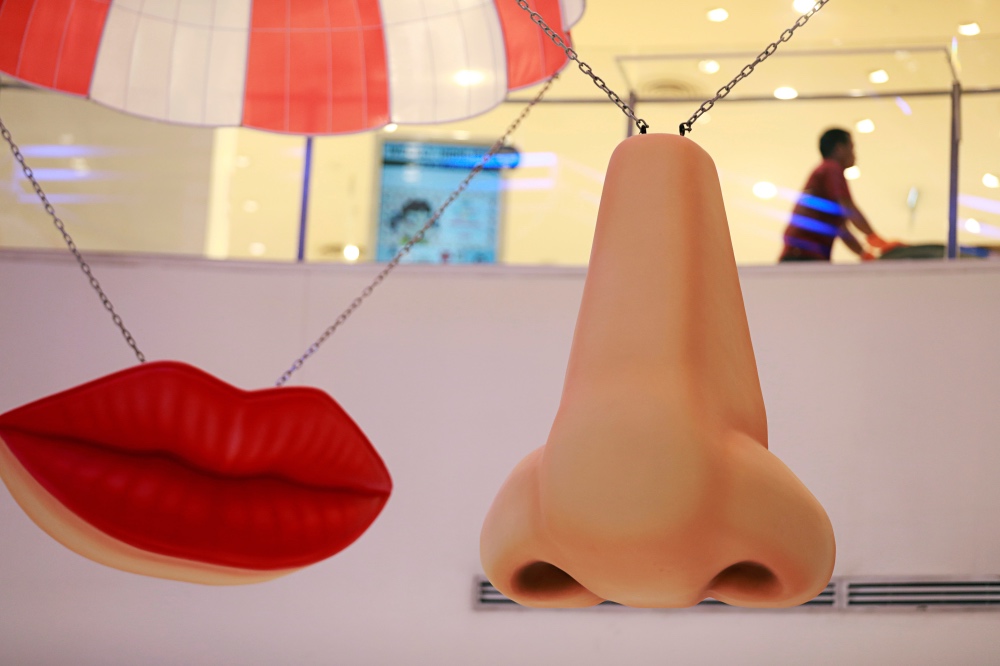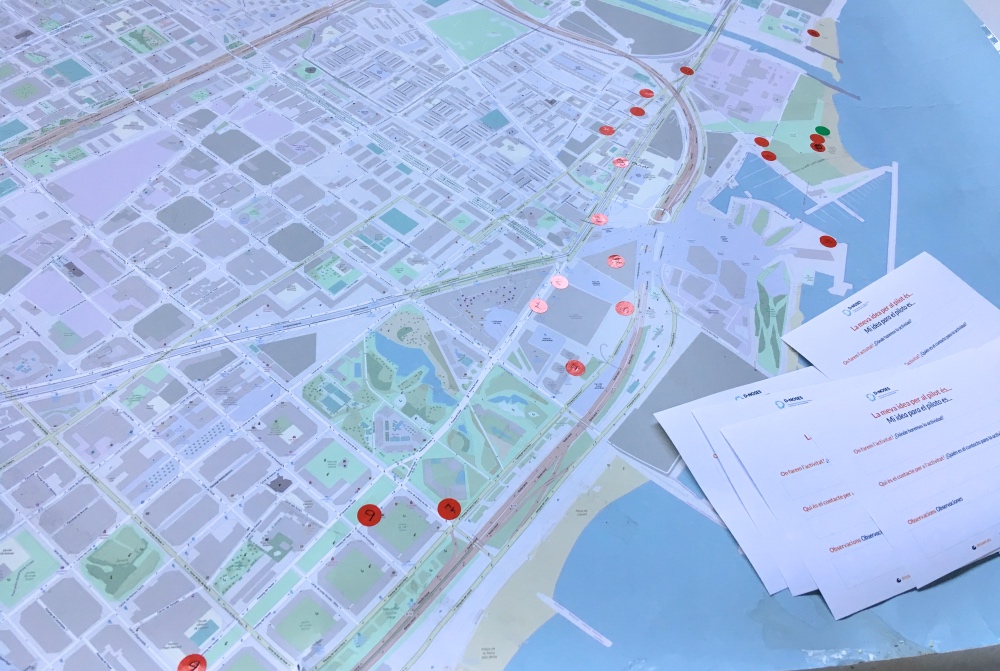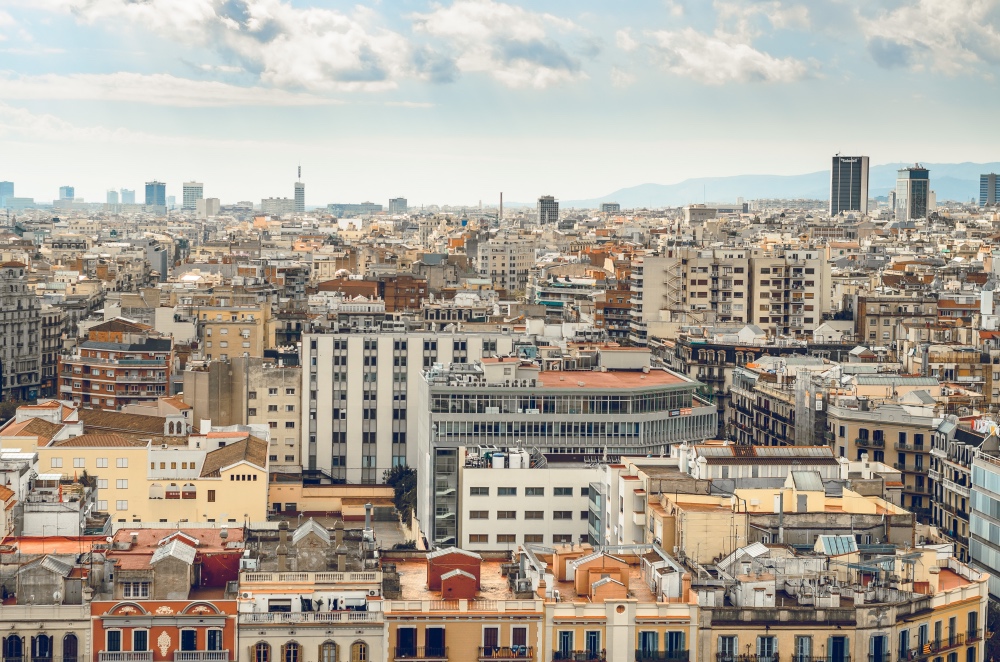
SOPHIE DAVIES, of Thomson Reuters Foundation, reports from Spain…
Barcelona, Spain
Thomson Reuters Foundation
Barcelona’s beaches might be best known for their bars and nightlife, but they also have a reputation for something more pernicious – unpleasant smells, from rubbish and sewage to marijuana and factory emissions.
Now, an app-based project aims to snuff out those scents using the collective power of crowdsourcing.
The D-Noses project, which began in 2016 and was officially piloted in 2018, lets local residents report their fragrance complaints – like garbage, chemicals and sewage – directly through the free OdourCollect app, to build the first-ever global odour map.

Lips and nose are seen at a shopping centre in Bangkok, Thailand, on 21st May, 2019. PICTURE: Reuters/Soe Zeya Tun.
Sponsored by the European Commission, with a budget of €3 million, the project is designed as a tool to “empower citizens who are suffering from regular odour nuisance”.
Odour pollution is the second most common cause of environmental complaint in Europe after noise, according to the website for the project.
“The objective is to correlate these [residents’] observations with industrial operations to spark improvements.”
– Rosa Arias, a Spanish chemical engineer and the app’s designer.
The three-year pilot involves eight European countries – including Spain, Greece, Germany and Portugal – along with Chile.
In Spain, the app is being tested in Poblenou, a newly gentrified district in the northeast of Barcelona.
The area is a hotspot for offensive odours, due to the factories left over from its time as the biggest industrial zone in Catalonia and its vicinity to the industrial facilities of the neighbouring Sant Adria de Besos district.
When the app collects enough information for the area, residents can use the map to put pressure on politicians to combat the smells, said Rosa Arias, a Spanish chemical engineer and the app’s designer.
“The objective is to correlate these [residents’] observations with industrial operations to spark improvements,” she told the Thomson Reuters Foundation.
As of late July, there were more than 270 complaints from at least 35 different users since 2016.
Most have complained about smells related to waste incineration and wastewater treatment coming into Poblenou from the industrial facilities in Sant Adria de Besos.
“The district has been transformed [gentrified], but – and this is something that happens in many places, not just in Barcelona – when [city planners] do urban planning, they don’t take account of the smells, so that’s where conflicts arise,” said Arias.
A spokeswoman for Barcelona City Hall said “there are some neighbourhoods where there’s industry where it [odour pollution] is worse but in general there is no odour problem in Barcelona compared to other cities where there are more factories.”
“I have the misfortune of living 400 metres from one of the industrial plants that emits the odours,” said Enric Navarro, a Poblenou resident who has helped drum up local support for the OdourCollect app.
The 65-year old, who has lived in the same area for more than 40 years, said the smells have been around for decades but have become more of a nuisance in the last four years or so, because of rising temperatures.
“Now we experience it a lot more in the summer because it is hotter than it used to be and we have our windows and terrace doors open more,” he explained.
The smells can be particularly bad in the evening, when the plants are transporting chemicals by lorry, he added.

A map of the Barcelona district of Poblenou indicating where locals have reported bad odours, taken during a meeting for a new odour collection app on 26th June. PICTURE: Thomson Reuters Foundation/Sophie Davies (image has been lightened)
There has been limited research into the impact of odour pollution on cities and their residents.
But, new projects to help deal with bad odours “can only be a positive thing,” noted Mar Viana Rodriguez, a senior researcher at the Barcelona-based Institute of Environmental Assessment and Water Research.
Some studies have looked into the physical and psychological impact of unpleasant odours, with medical experts saying frequent exposure can cause a number of ailments including headaches, stress and respiratory problems.
“If a person experiences sleep deprivation as a result of environmental odours, [that] produces psychological effects in terms of [lowered] alertness, ability to deal with stimuli and hypertension,” said Dennis Shusterman, a medical professor at the University of California, San Francisco.
“Odour pollution is an issue that is not very well known to the public.”
– Dennis Shusterman, a medical professor at the University of California, San Francisco
“Odour pollution is an issue that is not very well known to the public,” he added.
In the modest backroom of the neighbourhood association’s base in Poblenou, local residents were giving feedback, one-by-one, to OdourCollect’s project managers after trying out the app themselves.
“Everyone is interested because it is a problem that is directly affecting them,” said Arias.
Although the app is still in its pilot phase, people in at least 10 countries have already registered odours on it, from as far afield as Australia, Peru, Italy and Somalia.
Members of the public can also add comments to the app, if they want to report a smell that is not already listed, for example, Arias noted.
So far, users have asked the developers to add a list of “good” smells like flowers, herbs and food, and increase the list of urban smells to include marijuana, for one, she added.

The city of Barcelona, Spain. PICTURE: Anastasiia Tarasova/Unsplash.
But while the D-Noses developers work on increasing public engagement, sceptics have raised questions about crowdsourcing apps’ accuracy.
As Shusterman pointed out, the way different people perceive the same smell varies.
“Within the population there’s a great spread of sensitivities [to odour],” he stressed.
For that reason, crowdsourcing could be seen as a limited means of collecting data about potential public health problems, he said.
“The critique…is that the information based on public complaints alone is biased,” Shusterman noted.
But an odour map based on crowdsourced data could be an effective weapon against those who still deny that smells pose a health risk, he added.
Rodriguez, the IDAEA researcher, agreed that crowdsourcing apps are more useful for raising awareness than gathering high-quality data.
“But for odour pollution, there is not much data around, so a little bit of subjective data is better than nothing,” she said.
D-Noses has already produced a policy brief aimed at influencing politicians, Arias said.
She and others behind the project would like to see the map one day used to help residents shape local legislation based on “citizen science.”
“Odour pollution is little or not at all regulated in general on a global level,” she said. “In Spain, we do not have anything except for some ordinances at the municipal level.”
But Arias knows that even with the project’s data, it could take more for residents to convince politicians to make changes.
“Generating changes at the political level is our ultimate goal for the project. But, we cannot promise or guarantee it because it is not in our hands,” she said.





